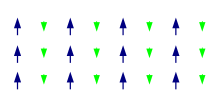Ferrimagnetism
- Not to be confused with ferromagnetism; for an overview see magnetism

In physics, a ferrimagnetic material is one that has populations of atoms with opposing magnetic moments, as in antiferromagnetism; however, in ferrimagnetic materials, the opposing moments are unequal and a spontaneous magnetization remains.[1] This happens when the populations consist of different materials or ions (such as Fe2+ and Fe3+).
Ferrimagnetism is exhibited by ferrites and magnetic garnets. The oldest known magnetic substance, magnetite (iron(II,III) oxide; Fe3O4), is a ferrimagnet; it was originally classified as a ferromagnet before Néel's discovery of ferrimagnetism and antiferromagnetism in 1948.[2]
Known ferrimagnetic materials include YIG (yttrium iron garnet), cubic ferrites composed of iron oxides and other elements such as aluminum, cobalt, nickel, manganese and zinc, hexagonal ferrites such as PbFe12O19 and BaFe12O19, and pyrrhotite, Fe1-xS.[3]
Effects of temperature

Ferrimagnetic materials are like ferromagnets in that they hold a spontaneous magnetization below the Curie temperature, and show no magnetic order (are paramagnetic) above this temperature. However, there is sometimes a temperature below the Curie temperature at which the two opposing moments are equal, resulting in a net magnetic moment of zero; this is called the magnetization compensation point. This compensation point is observed easily in garnets and rare earth-transition metal alloys (RE-TM). Furthermore, ferrimagnets may also have an angular momentum compensation point at which the net angular momentum vanishes. This compensation point is a crucial point for achieving high speed magnetization reversal in magnetic memory devices.[4]
Properties
Ferrimagnetic materials have high resistivity and have anisotropic properties. The anisotropy is actually induced by an external applied field. When this applied field aligns with the magnetic dipoles it causes a net magnetic dipole moment and causes the magnetic dipoles to precess at a frequency controlled by the applied field, called Larmor or precession frequency. As a particular example, a microwave signal circularly polarized in the same direction as this precession strongly interacts with the magnetic dipole moments; when it is polarized in the opposite direction the interaction is very low. When the interaction is strong, the microwave signal can pass through the material. This directional property is used in the construction of microwave devices like isolators, circulators and gyrators. Ferrimagnetic materials are also used to produce optical isolators and circulators. Ferrimagnetic minerals in various rock types are used to study ancient geomagnetic properties of Earth and other planets. That field of study is known as paleomagnetism.
Molecular ferrimagnets
Ferrimagnetism can also occur in molecular magnets. A classic example is a dodecanuclear manganese molecule with an effective spin of S = 10 derived from antiferromagnetic interaction on Mn(IV) metal centres with Mn(III) and Mn(II) metal centres.[5]
See also
References
- ↑ Spaldin, Nicola A. (2010). "9. Ferrimagnetism". Magnetic materials : fundamentals and applications (2nd ed.). Cambridge: Cambridge University Press. pp. 113–129. ISBN 9780521886697.
- ↑ L. Néel, Propriétées magnétiques des ferrites; Férrimagnétisme et antiferromagnétisme, Annales de Physique (Paris) 3, 137-198 (1948).
- ↑ Klein, C. and Dutrow, B., Mineral Science, 23rd ed., Wiley, p. 243
- ↑ C. D. Stanciu, A. V. Kimel, F. Hansteen, A. Tsukamoto, A. Itoh, A. Kirilyuk, and Th. Rasing, Ultrafast spin dynamics across compensation points in ferrimagnetic GdFeCo: The role of angular momentum compensation, Phys. Rev. B 73, 220402(R) (2006).
- ↑ Sessoli, Roberta; Tsai, Hui Lien; Schake, Ann R.; Wang, Sheyi; Vincent, John B.; Folting, Kirsten; Gatteschi, Dante; Christou, George; Hendrickson, David N. (1993). "High-spin molecules: [Mn12O12(O2CR)16(H2O)4]". J. Am. Chem. Soc. 115 (5): 1804–1816. doi:10.1021/ja00058a027.